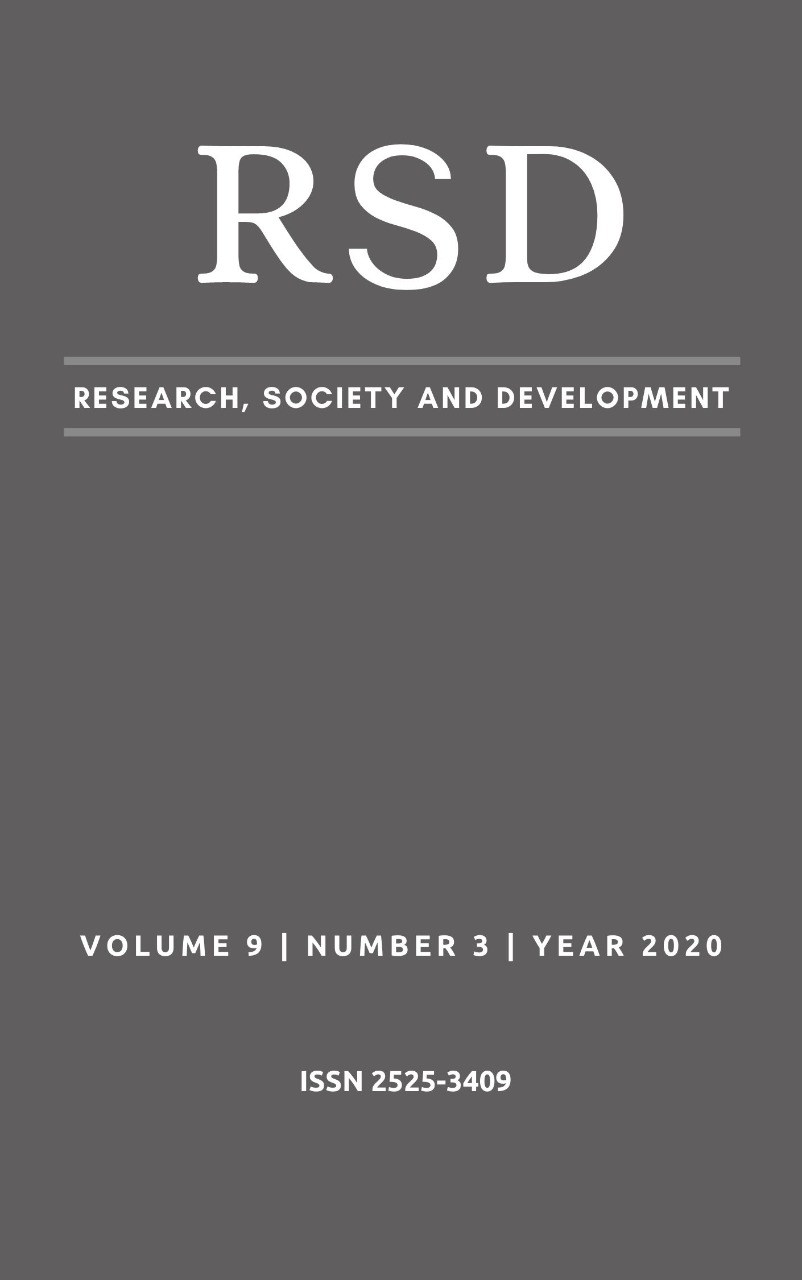Promoção de saúde para hipertensão arterial em grupo de adultos em Santos
DOI:
https://doi.org/10.33448/rsd-v9i3.2648Palavras-chave:
Hipertensão, Fatores de risco, Epidemiologia.Resumo
Avaliar a prevalência e os fatores de risco de um grupo de adultos para HAS e, simultaneamente, sensibilizá-los para a necessidade de prevenção através de mudanças no estilo de vida. Trata-se de um estudo descritivo, transversal e quantitativo em que foram avaliadas 96 pessoas. Utilizou-se questionário composto por oito perguntas que avaliaram os fatores de risco, estilo de vida e doenças. Mensurou-se peso, altura, circunferência abdominal e de pescoço, Pressão arterial (PA) e glicemia capilar de jejum (GCJ). Todos participantes assinaram um termo de consentimento livre e esclarecido e o projeto foi aprovado em comitê de ética. Aproximadamente 35% dos pacientes apresentaram Hipertensão e 17% Diabetes (DM2) com diagnóstico prévio determinado por médico. Os fatores de risco com as maiores prevalências foram: Circunferência abdominal alterada com 85,1%, índice de massa corporal (IMC) com 76%das pessoas acima de 25kg/m², 56,8% com PA alterada (PAS>120 e/ou PAD>80mmHg) e GCJ sendo que 48,1% apresentaram valores >100 mg/dL e 10,13% >126 mg/dL. Quanto à classificação pressórica, 15% dos avaliados apresentaram valores menores que 120x80mmHg, 20% no valor limítrofe (130-139/85-89) e aproximadamente 37% apresentou valores que são considerados como hipertensão. Dentre os fatores de risco, os que tiveram associação para ocorrência de HAS (IC95%) foram: Idade, circunferência abdominal (em homens) e IMC. Nas pessoas com mais de 60 anos houve aumento do risco em três vezes, também foi observado maior risco nas variáveis relacionadas à obesidade aumentando em até 2,5 vezes.
Referências
Brasil. (2006). Ministério da Saúde. Envelhecimento e saúde da pessoa idosa. Brasília:
Ministério da Saúde, Cadernos de Atenção Básica, n. 19. Série A. Normas e Manuais Técnicos. Recuperado em 16 fev 2020 de: http://189.28.128.100/dab/docs/publicacoes/cadernos_ab/abcad19.pdf
Cipullo, J.P., Martin, J.F.V., Ciorlia, L.A.S, Godoy, M.R.P, Cação, J.C, Loureiro, A.A.C (2010). Prevalência e fatores de risco para hipertensão em uma população urbana brasileira. Arq. Bras.
Cardiol. 94(4):519-526. Recuperado em 23 nov 2019 de: http://www.scielo.br/scielo.php?script=sci_arttext&pid=S0066-782X2010000400014&lng=en.
Costa, J.S.D., Barcellos, F.C, Sclowitz, M.L., Sclowitz, A.K.T., Castanheira, M.,& Olinto, M.T.A. (2007). Prevalência de Hipertensão Arterial em Adultos e Fatores Associados: um Estudo de Base Populacional Urbana em Pelotas, Rio Grande do Sul, Brasil. Arq Bras Cardiol; 88(1) : 59-65. Recuperado em 28 nov 2019 de: http://www.scielo.br/scielo.php?script=sci_arttext&pid=S0066-782X2007000100010.
Flor, L.S.,& Campos, M.R. (2017). Prevalência de diabetes mellitus e fatores associados na população adulta brasileira: evidências de um inquérito de base populacional. Rev B ras Epidemiol; 20(1): 16-29. Recuperado em 23 nov 2019 de: http://www.scielo.br/scielo.php?pid=S1415-790X2017000100016&script=sci_abstract&tlng=pt
Frizon, V.,& Boscaini, C. (2013). Circunferência do Pescoço, Fatores de Risco para Doenças Cardiovasculares e Consumo Alimentar. Rev Bras Cardiol.;26(6):426-34. Recuperado em 23 nov 2019 de: http://www.onlineijcs.org/english/sumario/26/pdf/v26n6a03.pdf
Gallagher, D., Visser, M., Sepulveda, D., Pierson, R.N., Harris, T.,& Heymsfield, S.B. (1996). How useful is body mass index for comparison of body fatness across age, sex and ethnic groups. Am J Epidemiol;143: 228-39. DOI: 10.1093/oxfordjournals.aje.a008733.
Gus, M., Fuchs, S.C., Moreira, L.B., Moraes, R.S., Wiehe, M., & Silva, A.F. (2004). Association between different measurements of obesity. Am J Hypertens. Jan;17(1):50-3. DOI: 10.1016/j.amjhyper.2003.08.010.
Kaufman, J.S., Asuzu, M.C., Mufunda, J., Forrester, T., Wilks, R.,& Luke, A. (1997). Relationship between blood pressure and body mass index in lean populations. Hypertension.; 30: 1511-6. DOI: 10.1161/01.hyp.30.6.1511.
Lim, S.S, Vos, T., Flaxman, A.D., Danaei, G., Shibuya, K., & Adair-Rohani, H. (2012). A comparative risk assessment of burden of disease and injury attributable to 67 risk factors and risk factor clusters in 21 regions, 1990-2010: a systematic analysis for the Global Burden of Disease Study 2010. Lancet; 380(9859): 2224-60. DOI:https://doi.org/10.1016/S0140-6736(12)61766-8.
Lobo, L.A.C., Canuto, R., Dias-da-Costa, J.S.,& Pattussi,M.P.(2017). Tendência temporal da prevalência de hipertensão arterial sistêmica no Brasil. Cad. Saúde Pública; 33(6). Recuperado de http://www.scielo.br/pdf/csp/v33n6/1678-4464-csp-33-06-e00035316.pdf
Malachias, M.V.B, Souza, W.K.S.B., Plavnik, F.L., Rodrigues, C.I.S., Brandão, A.A., & Neves, M.F.T. (2016). 7ª Diretriz Brasileira de Hipertensão Arterial. Sociedade Brasileira de Cardiologia. ISSN-0066-782X Volume 107, Nº 3, Supl. 3. Recuperado em 23 nov 2019 de: http://publicacoes.cardiol.br/2014/diretrizes/2016/05_HIPERTENSAO_ARTERIAL.pdf
Medeiros, C.C.M., Bessa, G.G., Coura, A.S., França, I.S.X., &Sousa, F.S. (2012). Prevalência dos fatores de risco para diabetes mellitus de servidores públicos. Rev. Eletr. Enf. jul/sep;14(3):559-69. Acesso em 14 nov 2019. Recuperado de: https://www.revistas.ufg.br/fen/article/view/14430/13378.
Mozaffarian, D., Benjamin, E.J., Go, A.S., Arnett, D.K., Blaha, M.J, & Cushman, M.(2015). American Heart Association Statistics Committee and Stroke Statistics Subcommittee. Heart disease and stroke statistics: update a report from the American Heart Association. Circulation.131: e29-e322. https://doi.org/10.1161/CIR.0000000000000659.
Ortiz, M.C.A.,& Zanetti, M.L. (2001). Levantamento dos Fatores de Risco para Diabetes Mellitus Tipo 2 em uma Instituição de Ensino Superior. Rev Latino-am Enfermagem; 9(3)58-63. https://doi.org/10.1590/S0104-11692001000300009.
Santana, L.C.B, Soares, T.C., Wenzel, A.P.B.H., Blanche, B.R., Benevides, L.K.B., Soares, T.C., Promoção à saúde de hipertensos e diabéticos a partir da problematização do território. Research, Society and Development, v. 9, n.1, e141911492, 2020. DOI: http://dx.doi.org/10.33448/rsd-v9i1.1492.
Secretaria Municipal da Saúde.(2011). Boletim ISA - Capital, nº 4: Prevalência de Hipertensão Arterial e Diabetes Mellitus. Estado Nutricional de Adolescentes. São Paulo: CEInfo, 40 p. Recuperado em 20 nov 2019 de: https://www.prefeitura.sp.gov.br/cidade/secretarias/upload/saude/arquivos/publicacoes/Boletim_ISA_4.pdf
Strelec, M.A.A.M., Pierin, A.M.G,& Mion-Junior,D.(2003) A Influência do Conhecimento sobre a Doença e a Atitude Frente à Tomada dos Remédios no Controle da Hipertensão Arterial. Arq Bras Cardiol, volume 81 (nº 4), 343-8. Recuperado em 16 nov 2019 de: http://publicacoes.cardiol.br/abc/2003/8104/8104002.pdf
Downloads
Publicado
Edição
Seção
Licença
Autores que publicam nesta revista concordam com os seguintes termos:
1) Autores mantém os direitos autorais e concedem à revista o direito de primeira publicação, com o trabalho simultaneamente licenciado sob a Licença Creative Commons Attribution que permite o compartilhamento do trabalho com reconhecimento da autoria e publicação inicial nesta revista.
2) Autores têm autorização para assumir contratos adicionais separadamente, para distribuição não-exclusiva da versão do trabalho publicada nesta revista (ex.: publicar em repositório institucional ou como capítulo de livro), com reconhecimento de autoria e publicação inicial nesta revista.
3) Autores têm permissão e são estimulados a publicar e distribuir seu trabalho online (ex.: em repositórios institucionais ou na sua página pessoal) a qualquer ponto antes ou durante o processo editorial, já que isso pode gerar alterações produtivas, bem como aumentar o impacto e a citação do trabalho publicado.


